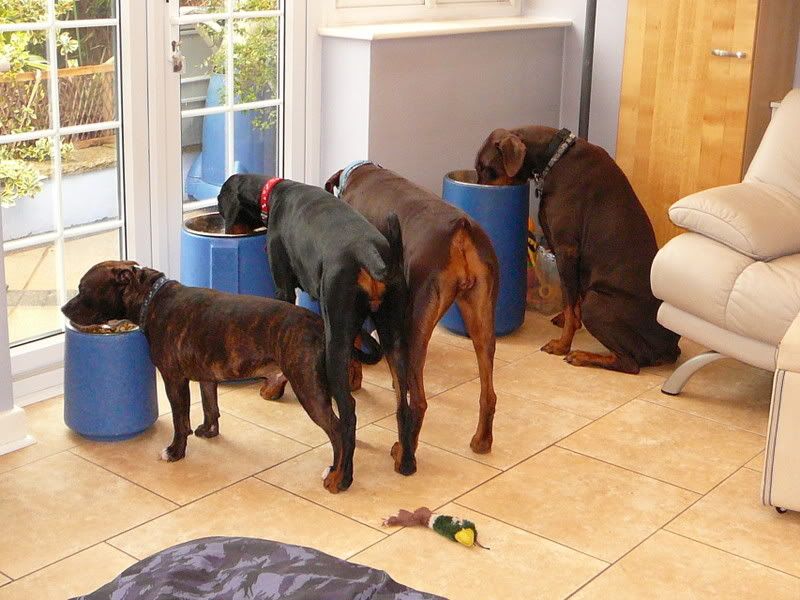|
|
Location: Wiltshire, UK
Joined: Nov 2008
Posts: 5,374
|
03-08-2009, 11:49 AM
Food storage
How do you store your dried dog food/kibble?We've always used this - http://www.zooplus.co.uk/shopzilla_u..._storage/13680 - kept in the cupboard under the stairs but it was suggested that it might not be the best way to keep food that is obviously in there for a long time.
Thoughts?

|
|
|
Location: Fife Scotland
Joined: Jun 2004
Posts: 1,946
|
03-08-2009, 11:57 AM
Only thing I would feel with the bins in the link would be they aren't mouse proof but if you don't have a mouse problem look fine to me. Also I wonder if they would let in damp sorry don't mean to be so negative

|
|
|
Location: Preesall, Lancashire
Joined: Feb 2006
Posts: 5,622
|
03-08-2009, 12:04 PM
When it's open, the sack sits in our utility room, with the top folded down and over when not in use.
Can't be bothered with expensive bits and bats of kit for sacks of dog food!

|
|
|
Location: Scottish Borders
Joined: Nov 2006
Posts: 13,902
|
03-08-2009, 01:04 PM
Need to go and have a search now and see if I can find something more about that.

|
|
|
Location: Preesall, Lancashire
Joined: Feb 2006
Posts: 5,622
|
03-08-2009, 01:23 PM
I'm sure I've read somewhere that it is important to keep kibble sealed in air tight containers, but I can't remember exactly why - something to do with mites and the kibble going off if it gets damp?
Need to go and have a search now and see if I can find something more about that.
Need to go and have a search now and see if I can find something more about that.
We've never had trouble with kibble etc going off... doesn't really hang around for long enough with Murphy munching it!!

|
|
|
Location: Scottish Borders
Joined: Nov 2006
Posts: 13,902
|
03-08-2009, 01:38 PM
http://www.heska.com/allercept/client_info.asp#mites
Controlling Storage Mite Exposure
Storage mites are often found in grain bins and dry feed stuffs including dog and cat food. Pets exposed to stored product mites by consumption of food containing these mites are therefore at risk of sensitization and allergic reaction. Storage mite bodies and mite feces are a source of potent allergens. Dogs and cats may be exposed to mite body parts and excreta through inhalation and percutaneous absorption of such allergens.
One of the storage mites, Tyrophagus putrescentiae, the mold mite, is very common but usually goes unnoticed except in occasions when it becomes abundant. Mold mites only develop where there is moisture or high humidity. Infestations have been found in cheese, flour, grain, seeds, bulbs, straw, wallpaper, furniture, dried fruits, and cereal foods. Since even dry foods have some amount of moisture (usually around 10%) they are susceptible to mold and provide an optimum breeding ground for the storage mites. Hypersensitivity to storage mites is a worldwide problem. Data and information regarding allergy to storage mites has increased rapidly over recent years.
Hyposensitization therapy can be effective in atopic patients with storage mite allergy. Some patients are sensitive only to mites, and in these cases immunotherapy is highly effective. In addition, an effective environmental control regimen can prove useful in minimizing the patient's discomfort and lessening immediate signs of allergy.
Although it is virtually impossible to totally eliminate storage mites from the environment, steps can be taken to inhibit their multiplication and thereby minimize exposure to storage mite allergens.
The following suggestions should prove useful in controlling storage mite populations:
Store pet foods in airtight containers. Avoid storage of pet food in garages, sheds or basements.
Do not use old or outdated pet food. Check food for dust, mold or odors and remove questionable food from the house and discard immediately.
Wash food containers frequently in detergent and HOT (130 F) water. Dry completely before refilling with food.
Dispose of pet food bags immediately outside of the house.
Do not stockpile foods. Purchase only what is needed for 30 days at a time.
Avoid keeping fruit and other foods that can mold on the counter.
Check food bags for tears or holes prior to purchase.
Low quality pet foods with a high quantity of particulate debris at the bottom of the bag should be avoided."

|
|
|
Location: Northern USA
Joined: May 2009
Posts: 1,847
|
03-08-2009, 02:14 PM
That nylon container might be OK if it is coated to exclude air and moisture.
We have a plastic bin Pro Plan was giving away years ago. With a little work, we can even get a 40 pound bag in it, bag and all. The folded down bag provides another layer of protection. I was pleased that Wal-Mart recently started carrying a 30 pound bag of Iams at less per pound than the 40 pound ones elsewhere. I like that size better than the 17.5 or 40 pounds ones, neither having to run to the store all the time or lasting forever.
One more advantage of keeping the bag inside another container is you have the bag if you ever need to check it. None of the common brands of kibble were part of the terrible recall the year before last, but who knows what might happen.
If you want the convenience and economy of buying larger sizes, I would buy an air and moisture tight container big enough to put the bag in. I have even seen screw top containers made for dog food.

|
 |
«
Previous Thread
|
Next Thread
»
| Currently Active Users Viewing This Thread: 1 (0 members and 1 guests) | |
|
|









